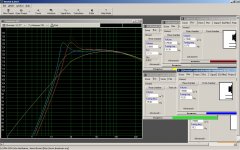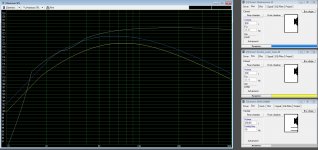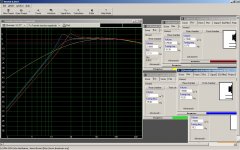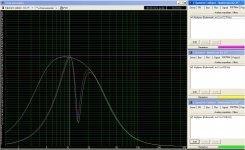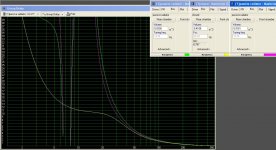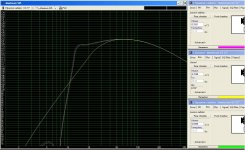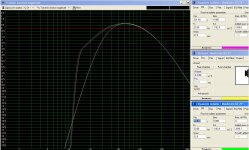Hi all,
greetings from New Zealand (yep another kiwi on here ).
).
I've been into my hifi for a number of years now, sound has always mystified me, I have always fiddled with speakers since a young age, enjoyed hearing the sound, accuracy and volume that differing speakers and combinations produce.
This quest for the ever-moving goalposts of percieved perfection has taken me down the subwoofer route again. I can remember puchasing my current NZ built 10" image sub and being astonished at the price jump from 10" to 12" for properly built subs of most decent hifi brands - in order of thousands of dollars for 2". The image sub has a seriously solid box, small dimensions, however tight and accurate bass to which many have attested. Many fellow muso mates love to test out new or developing tracks on my rig, as it has worked up a name for itself. Only problem is when my rig gets to play in a lounge (where it will be stationed in future) a 10" sub has to really work hard to make an impression, frankly it is not enough to provide the sub 30hz to infrasonic response I seek.
In future I will likely be purchasing a pair of B&W 802 nautilus (gasp yes I know, not building ) and diying multiple monoblocks of either 'as close to zero feedback if not' amps as possible, or building tube amps as I have plenty of books on them or some other unusual solution (I'm better with electronics than crafting), as I really cannot see myself having time, skill or tools to build better 'full range' speakers for a very long time (unless you wonderful lot and myself can convince me otherwise
) and diying multiple monoblocks of either 'as close to zero feedback if not' amps as possible, or building tube amps as I have plenty of books on them or some other unusual solution (I'm better with electronics than crafting), as I really cannot see myself having time, skill or tools to build better 'full range' speakers for a very long time (unless you wonderful lot and myself can convince me otherwise  ).
).
However this leads me to a DIY sub.. the reason I have been trawling this forum and playing around with newly discovered software like winISD which you all seem to be familliar with. The cost of pre-built subs is prohibitive and they seem to have much less involved than building fullrange setup. The maths I've seen show that for what I'm looking at (clarity, SPL and response depth wise) I may as well scratch 18" subs and go minimum 21" in a huge sealed box. All the 18"s i've ever heard didn't have the presense down at hugely low frequencies that a nice rack of 21"s I heard a few times did. Plus nothing says bass more than a ******* sub, we all love sexy speakers don't we
Thirdly this may be proof of concept design (however a PA design would likely be different for higher SPL) for the local opus audio pa rig which is running 4 pairs of SB218s for lows, only one in New Zealand and in all my years in hospo/entertainment, the cleanest, least ear eating thing i've heard that wasn't a dedicated hifi system.
Requirements:
1) quality of sound/definition above all
1.5) flattish (+/- 1-2db) from 20~hz to 35hz
2) extremely low infrasonic response (15hz without too much dropoff would be desirable)
3) size is not a huge issue (can budget up to 3-4000L)
4) only needs to get up to 40hz (later on mid 30s) and get down to 15-10hz.
5) bare minimum circuitry in signal path other than amp (may eventually try large russian gu81m PP tubes
6) must be able to reproduce everything from the subtle reverberations of the resonator of a bass drum, without clouding the wooly thunk sound of a beaters' energy dispersing into the skin and slightly into the shell of the drum (guess what I played... ;p), through to sometimes delicate yet always looming kettle drums, thunder claps and able to do the 'WAH-WAH' of a dubstep track (yeah i know usually reggae scoop style), also the pounding bass of some of new zealands finest hard dance. And godzilla's heavy footsteps to top it all off!
Options for construction
Wood/concrete combination for reduced weight but concrete sound characteristic benefit - is this even possible? Have not found anything on the net about it.
Or exotically braced wood construction (wondering about solid steel bracing)..
I have plenty of biker mates who have worked with fibreglass/carbonfibre who can teach me, so this is also an option for exterior sculpting and airflow around the box if this needs to be taken into account.
Aiming for PD2450/2150 or similar quality driver. I don't mind shelling out a small fortune on an extremely well constructed driver, rather than skimping and wishing I'd paid that little extra for that extra refinement and quality.
One question I have about the PD2450 is that its resonant frequency is quite high, can a large sealed box correct this? I'm gagging for that extremely solid and flat response from 30~40hz to around 20hz. Initial WINISD numbers were not what I was seeking however I'm rather new to the sub building game and software.
Reason I have moved towards sealed design is that almost every standard ported/vented sub box I've ever heard has sounded like a speaker cone (especially obvious with the added ports on the new opus bins) or has been lumpy as hell or just that sort of resonant chuffy sound down at the lowest ranges of response. (ducks for cover) Every horn I've heard has sounded like a horn... Impressive output and size of enclosure none the less but not the sound I'm looking for. I guess I'm just anal retentive and annoyingly picky about sound in general. I want as little colouration as humanly possible.
Current room is wood lined brick wall with carpeted concrete floor approx 4.5x5m so perfect for a smaller sub, lounge is same construction at least 15m by 10m so plenty of breathing room.
Tips, hints, feedback or comments would be gladly appreciated.
Burning issues for me currently is
1) how to get extremely low response, with flattish +/-2db 35~ to 20hz outta pd2450 or similar.. how to design the box to resonate at 15" as it seems this is a common approach to solve the problem with horns.
2) wood lined with internal concrete construction or sandwich - anyone ever seen/done it?
3) spikes big enough to mount a 24" sub box without displacing concrete floors lol.
4) does the golden ratio truely make a difference to sub sound (just measured my dm604s and they appear to be golden ratio length-width...)?
Thanks for reading this poorly steered, rambling first post
greetings from New Zealand (yep another kiwi on here
I've been into my hifi for a number of years now, sound has always mystified me, I have always fiddled with speakers since a young age, enjoyed hearing the sound, accuracy and volume that differing speakers and combinations produce.
This quest for the ever-moving goalposts of percieved perfection has taken me down the subwoofer route again. I can remember puchasing my current NZ built 10" image sub and being astonished at the price jump from 10" to 12" for properly built subs of most decent hifi brands - in order of thousands of dollars for 2". The image sub has a seriously solid box, small dimensions, however tight and accurate bass to which many have attested. Many fellow muso mates love to test out new or developing tracks on my rig, as it has worked up a name for itself. Only problem is when my rig gets to play in a lounge (where it will be stationed in future) a 10" sub has to really work hard to make an impression, frankly it is not enough to provide the sub 30hz to infrasonic response I seek.
In future I will likely be purchasing a pair of B&W 802 nautilus (gasp yes I know, not building
However this leads me to a DIY sub.. the reason I have been trawling this forum and playing around with newly discovered software like winISD which you all seem to be familliar with. The cost of pre-built subs is prohibitive and they seem to have much less involved than building fullrange setup. The maths I've seen show that for what I'm looking at (clarity, SPL and response depth wise) I may as well scratch 18" subs and go minimum 21" in a huge sealed box. All the 18"s i've ever heard didn't have the presense down at hugely low frequencies that a nice rack of 21"s I heard a few times did. Plus nothing says bass more than a ******* sub, we all love sexy speakers don't we
Thirdly this may be proof of concept design (however a PA design would likely be different for higher SPL) for the local opus audio pa rig which is running 4 pairs of SB218s for lows, only one in New Zealand and in all my years in hospo/entertainment, the cleanest, least ear eating thing i've heard that wasn't a dedicated hifi system.
Requirements:
1) quality of sound/definition above all
1.5) flattish (+/- 1-2db) from 20~hz to 35hz
2) extremely low infrasonic response (15hz without too much dropoff would be desirable)
3) size is not a huge issue (can budget up to 3-4000L)
4) only needs to get up to 40hz (later on mid 30s) and get down to 15-10hz.
5) bare minimum circuitry in signal path other than amp (may eventually try large russian gu81m PP tubes
6) must be able to reproduce everything from the subtle reverberations of the resonator of a bass drum, without clouding the wooly thunk sound of a beaters' energy dispersing into the skin and slightly into the shell of the drum (guess what I played... ;p), through to sometimes delicate yet always looming kettle drums, thunder claps and able to do the 'WAH-WAH' of a dubstep track (yeah i know usually reggae scoop style), also the pounding bass of some of new zealands finest hard dance. And godzilla's heavy footsteps to top it all off!
Options for construction
Wood/concrete combination for reduced weight but concrete sound characteristic benefit - is this even possible? Have not found anything on the net about it.
Or exotically braced wood construction (wondering about solid steel bracing)..
I have plenty of biker mates who have worked with fibreglass/carbonfibre who can teach me, so this is also an option for exterior sculpting and airflow around the box if this needs to be taken into account.
Aiming for PD2450/2150 or similar quality driver. I don't mind shelling out a small fortune on an extremely well constructed driver, rather than skimping and wishing I'd paid that little extra for that extra refinement and quality.
One question I have about the PD2450 is that its resonant frequency is quite high, can a large sealed box correct this? I'm gagging for that extremely solid and flat response from 30~40hz to around 20hz. Initial WINISD numbers were not what I was seeking however I'm rather new to the sub building game and software.
Reason I have moved towards sealed design is that almost every standard ported/vented sub box I've ever heard has sounded like a speaker cone (especially obvious with the added ports on the new opus bins) or has been lumpy as hell or just that sort of resonant chuffy sound down at the lowest ranges of response. (ducks for cover) Every horn I've heard has sounded like a horn... Impressive output and size of enclosure none the less but not the sound I'm looking for. I guess I'm just anal retentive and annoyingly picky about sound in general. I want as little colouration as humanly possible.
Current room is wood lined brick wall with carpeted concrete floor approx 4.5x5m so perfect for a smaller sub, lounge is same construction at least 15m by 10m so plenty of breathing room.
Tips, hints, feedback or comments would be gladly appreciated.
Burning issues for me currently is
1) how to get extremely low response, with flattish +/-2db 35~ to 20hz outta pd2450 or similar.. how to design the box to resonate at 15" as it seems this is a common approach to solve the problem with horns.
2) wood lined with internal concrete construction or sandwich - anyone ever seen/done it?
3) spikes big enough to mount a 24" sub box without displacing concrete floors lol.
4) does the golden ratio truely make a difference to sub sound (just measured my dm604s and they appear to be golden ratio length-width...)?
Thanks for reading this poorly steered, rambling first post
The only existing project I've seen with these PD drivers is this:
Humble Homemade Hifi
Which seems a bit similar to what you're trying to achieve. Be careful if you copy this design as it uses lead!
Humble Homemade Hifi
Which seems a bit similar to what you're trying to achieve. Be careful if you copy this design as it uses lead!
A well designed vented sub can get you more output with no degradation in quality, if you know exactly what the lowest frequency is that you want to reproduce. Since that number seems to be 15Hz, it's almost trivial to design a high output sub, but you want to use an actual subwoofer rather than a pro driver, unless you need midbass efficiency.
1) Why do you want it to resonate, and why do you mention horns if you have already ruled them out?
2) It's pointless. In a sub application, all it does is add mass (which is not necessarily a bad thing, but it's usually overkill when you use concrete)
3) Do you mean damaging concrete floors? Anyway, since budget is not a huge concern, simply design them yourself and have a local machine shop make them out of whatever material you desire. Stainless steel is a lovely material, by the way.
4) Absolutely not.
EDIT: This is probably the best driver you can get: http://www.diycable.com/main/product_info.php?cPath=24&products_id=692
1) Why do you want it to resonate, and why do you mention horns if you have already ruled them out?
2) It's pointless. In a sub application, all it does is add mass (which is not necessarily a bad thing, but it's usually overkill when you use concrete)
3) Do you mean damaging concrete floors? Anyway, since budget is not a huge concern, simply design them yourself and have a local machine shop make them out of whatever material you desire. Stainless steel is a lovely material, by the way.
4) Absolutely not.
EDIT: This is probably the best driver you can get: http://www.diycable.com/main/product_info.php?cPath=24&products_id=692
Last edited:
Gidday N4CR,
Welcome to the forum and don't worry about long and rambling posts, they are a common sight here!
Looks like you're targetting a reasonably high efficiency sub with your choice of driver. those PD subs are VERY well constructed, I saw the PD2450 once when in the UK and believe me it weighed an absolute ton, something like over 30Kg I think!
You could also look at 21" drivers from B&C, and Beyma. Do a search here and see what drivers are getting good recommendations.
I'm not sure if PD have a NZ or OZ distributor? Airfreight would cost a packet to get the PD drivers direct from the UK.
For cabinet construction, have a look at Plyguy on Trade Me. He has all sorts of oversize plywood on offer, like this 45mm stuff:
MONSTER PLY - 45mm thick PHWAARGH, from The PLYGUY for sale - TradeMe.co.nz - New Zealand
I got something similar, 34mm thick and am planning on using it for an enclosure as an inner carcass, with a skin of thin veneered ply/mdf over the top.
One other thought for a sealed box is to use a Linkwitz transform circuit ahead of your sub amp to provide some extra bass extension. With a 21" or 24" driver your excersion is going to be tiny at anything but huge volumes so you've got plenty of headroom to play with.
ESP - The Linkwitz Transform Circuit
And it goes without saying I'd be seriously interested in dropping by for a listen when you get it built!
Cheers,
Len.
Welcome to the forum and don't worry about long and rambling posts, they are a common sight here!
Looks like you're targetting a reasonably high efficiency sub with your choice of driver. those PD subs are VERY well constructed, I saw the PD2450 once when in the UK and believe me it weighed an absolute ton, something like over 30Kg I think!
You could also look at 21" drivers from B&C, and Beyma. Do a search here and see what drivers are getting good recommendations.
I'm not sure if PD have a NZ or OZ distributor? Airfreight would cost a packet to get the PD drivers direct from the UK.
For cabinet construction, have a look at Plyguy on Trade Me. He has all sorts of oversize plywood on offer, like this 45mm stuff:
MONSTER PLY - 45mm thick PHWAARGH, from The PLYGUY for sale - TradeMe.co.nz - New Zealand
I got something similar, 34mm thick and am planning on using it for an enclosure as an inner carcass, with a skin of thin veneered ply/mdf over the top.
One other thought for a sealed box is to use a Linkwitz transform circuit ahead of your sub amp to provide some extra bass extension. With a 21" or 24" driver your excersion is going to be tiny at anything but huge volumes so you've got plenty of headroom to play with.
ESP - The Linkwitz Transform Circuit
And it goes without saying I'd be seriously interested in dropping by for a listen when you get it built!
Cheers,
Len.
What kind of amplifier will you be driving this with? You've mentioned tubes a couple of times, but I want to be sure. If you're planning on driving it with a tube amp, I'd strongly advise you not to. Plate amps aren't hugely expensive any more...
Here's something to mull over: instead of choosing from the (very few) huge subwoofers out there, why not get several smaller ones? In terms of sheer area, 4x12"=1x24", but I bet you can find a lot more 12" drivers available. If you really wanted to get some bass, a few (8 would be quite cool) 15" drivers would do well. You'd have the area of 2x 30" drivers, which is likely sufficient.
Len, the excursion of the drivers when a Linkwitz Transform is added will always be excessive. At 15 Hz (f3 when the appropriate circuit is added), excursion is 5mm from rest, so 10mm p/p, and the output is only 95dB (at 15Hz), so it's still unlikely to be heard.
Chris
Here's something to mull over: instead of choosing from the (very few) huge subwoofers out there, why not get several smaller ones? In terms of sheer area, 4x12"=1x24", but I bet you can find a lot more 12" drivers available. If you really wanted to get some bass, a few (8 would be quite cool) 15" drivers would do well. You'd have the area of 2x 30" drivers, which is likely sufficient.
Len, the excursion of the drivers when a Linkwitz Transform is added will always be excessive. At 15 Hz (f3 when the appropriate circuit is added), excursion is 5mm from rest, so 10mm p/p, and the output is only 95dB (at 15Hz), so it's still unlikely to be heard.
Chris
looks like the Mael is the one for now..
454casull; I especially loved the idea with construction of the spikes and have now gone down the ported route... I guess I've decided it's enough of a challenge to try eliminate chuffing to be worth it for the numbers
Initially I may have to settle for the often hifi-dreaded class D amplification solution (which is obviously easiest initially), I have a few options for the time being.. I could go opus HD series amp for a nice price as they are one of few class D amps I find acceptable although they have a rather noisy fan for home use (not that I couldn't change it..), 1500w per channel up to 2500w depending on model however I'd need to ask my mate what impedance loads it is made for.. could be for specific opus drivers, however they have been used across a range of different drivers and manufacturers as the cabinets have been updated. It also opens the path to running each voice coil with a single channel or expanding to two subs with both coils in series. I don't think I could make all this effort building a sub like this to chuck them on crowns or some other cheapie, I've never enjoyed the sound at gigs from them or most other cheaper pro amps, find them too harsh. Could try save some $$ and look at one of many other homebrew transistor builds which have been done before, or go ground up with my electrical engineering mate helping me learn circuit design. In future I would love to embark on a GU46 or dual SET GU81M project (one for each coil), that's if I can source or find a builder of suitable transformers and afford them.... They may not be terrific quality for 40-0hz but if they are then I'd be happy as. Rather not go ridiculous amounts of normal 'large' valves. Valves is the most difficult solution but I think that if I can get a valve like harmonic distortion and sound then i'd be happy, that clean and clear and 'belching' bass sound.. just something about them that paper figures don't always explain I guess.
On the drivers side i've taken the mael x21 into heart and run plenty of different configurations through WINISD vs pd and a few other drivers.
The sealed box wins every time for 10-1hz but the ported .5-2.7m3 box with 2x 12" ports seems to be the spot with the maelstrom winning hands down. PD 2450 is nice and very efficient however just really seems to want to do higher frequencies more than the 20-40stuff im really looking for.
Have considered multiple smaller drivers - a good 18 or 15 setup could work with the available cone area and perhaps save a little coin however it becomes a similar amount of work and more holes and bit more amp tutuing either way. I'd rather stick with the 21" and its barely needed excursion for normal listening volumes, plus it's been a childhood dream to own a 'statement' single sub ever since I saw a 32" clarion HT demo box at a car/tech/living expo once Damn that thing was LOUD. Filled a 200x150m building so well I could hear it outside 30m away from the door - sounded like a good 15" or bigger was a cranking few cars away but with a 'huge metal building holding a mother sub' presence i've never heard since
Damn that thing was LOUD. Filled a 200x150m building so well I could hear it outside 30m away from the door - sounded like a good 15" or bigger was a cranking few cars away but with a 'huge metal building holding a mother sub' presence i've never heard since 
However in my biased flat response curve seeking sillyness of sealed enclosures has really come back to bite me.. a single sealed mael of any size box will simply not pull 120db @ 20hz any way i try.. so back to drawing board. 2 will what an infrasonic monster too...
what an infrasonic monster too...
Here's what I've got so far after doing a bender till 7am morning of twiddling and starting all over again....
all 20deg ambient with 40 degree rise and 1500w in
yellow 2m3 sealed love the rolloff
grey 0.5m3 WAF proof (as much as a 21" woofer can be waf proof lol) 2"x20" x14" deep port good compromise sub? perhaps more retail dimensions lol
red 2.7m3 non-WAF approved 2x12" x7.54" deep ports to reduce chuffing (is this enough?) and my favourite high output so far...
green a tradeoff but damn flat, low chuff with dual 12" ports and nice 108db 10hz
blue is a green setup tradeoff smaller ports 2x8"x14" deep and box
orange 1.5m3 19.2hz tuning 16" x16" deep port not a bad compromise either
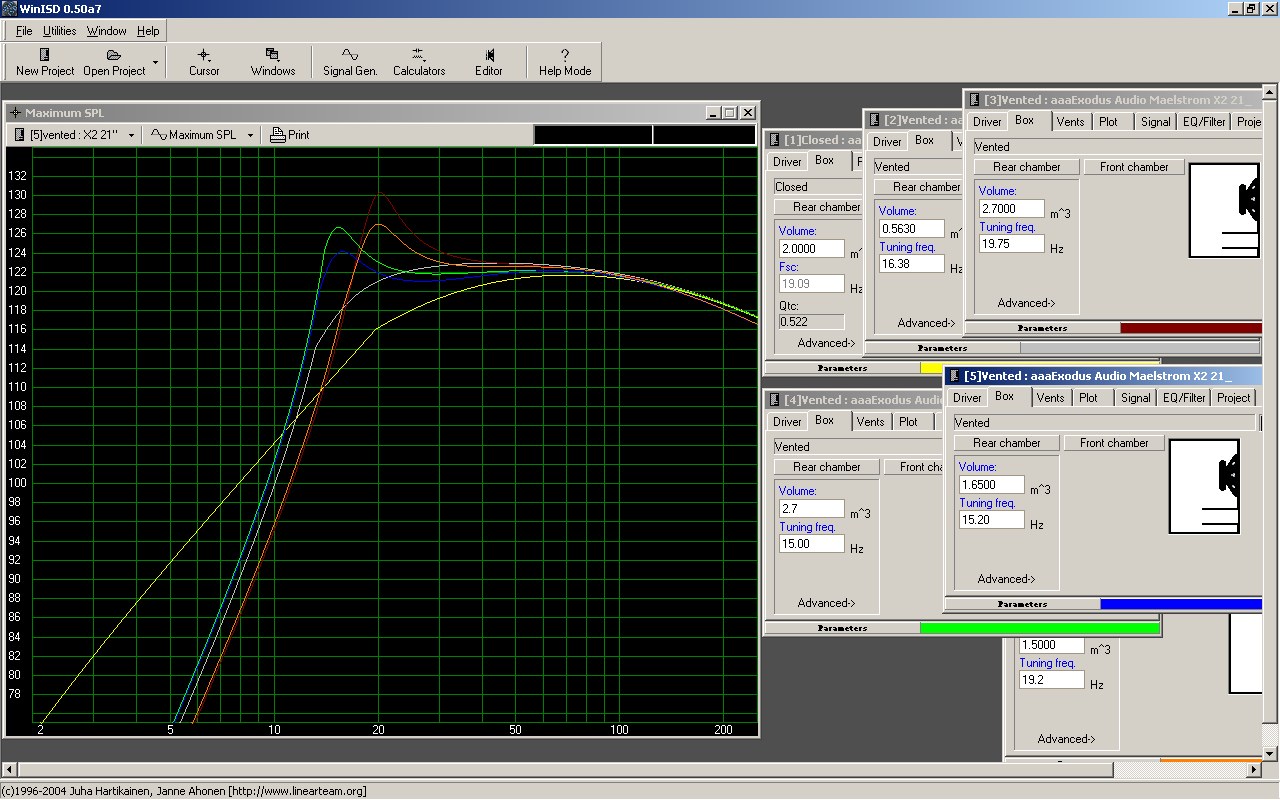
I have stumbled upon a set of curves i'd forgotten a long time ago.. the 'equal loudness curves' http://upload.wikimedia.org/wikipedia/commons/thumb/4/47/Lindos1.svg/2000px-Lindos1.svg.png which reckon for 100 phon reference in mid to low range its pretty flat till 100hz which it gradually increases till when you need about 128-130 db @ 20hz to keep up, vastly more db required than at 300hz.... so as far as I understand and hear on mine and other rigs.... once you approach under 30-40hz it appears to drop off even though everything is rattling, to compensate you need a metric crap-tonne of spl to get a percieved flat response. So if I rigidly stick with a flat response on paper I get a percieved dropoff in sound volume even though it's 'flat', which sure as hell isn't what I'm looking for, I want it to sound flat to me, not a graph. I'm guessing this is one of the reasons why the sub has been designed with a 16hz fs.
ANyone have any comments or feedback on especially the equal loudness curve and has anyone else designed around it. I understand it is an average and may be different to me but it's a good start for now.
However, will tuning it so peaky (dark red line) make it sound rubbish down low around 25-20hz? And yes I am expecting the room to screw up any decent build hehehe.... digital eq correction? Whats the lowest noise approach? Seen velodyne controllers around which can tune to room and adjust, any hints on these or other types?
I notice cone excursion appears to go over 60mm around 10hz on most setups, is this just winisd not modeling it properly or what will actually happen (aka it pops @ 1500w rated at 5hz????)?
Have checked out the Beyma and B&C drivers... nice drivers (love the waterproofing too!) but they don't deliver the goods for what I'm seeking - orchestra/drum kit reference spl when occasionally needed. I really want this sub for overhead, not destroying eardrums and as good sound as it comes. I will keep em [other drivers] in my mind should a diy main speaker ever come to fruition
Porting wise.. down or front or back or sideways? Will downfiring dissipate more into the ground thus creating better infrasonic response? What's cleanest sounding usually? Or does it not really matter which way with such a setup...? Have looked into PRs but cant get the numbers I seek from them... unusual things but cool.. seen some pretty crazy subs with them. One I think was about 2m high, stuck in a 30something floor penthouse apartment of course, 22" PR with like 9 woofers driving it hehe.
Len,
PD don't have any distributors here, afaik it's even hard getting them into USA >_< Thank you very much for the trademe heads up that'll do well that wood plus a little bracing. Will investigate the linkwitz transform circuit tomorrow and see how it goes.. so close yet so far with the sealed... its rolloff keeps me wondering
that'll do well that wood plus a little bracing. Will investigate the linkwitz transform circuit tomorrow and see how it goes.. so close yet so far with the sealed... its rolloff keeps me wondering 
Anyway its time for even the wicked to rest
454casull; I especially loved the idea with construction of the spikes and have now gone down the ported route... I guess I've decided it's enough of a challenge to try eliminate chuffing to be worth it for the numbers
Initially I may have to settle for the often hifi-dreaded class D amplification solution (which is obviously easiest initially), I have a few options for the time being.. I could go opus HD series amp for a nice price as they are one of few class D amps I find acceptable although they have a rather noisy fan for home use (not that I couldn't change it..), 1500w per channel up to 2500w depending on model however I'd need to ask my mate what impedance loads it is made for.. could be for specific opus drivers, however they have been used across a range of different drivers and manufacturers as the cabinets have been updated. It also opens the path to running each voice coil with a single channel or expanding to two subs with both coils in series. I don't think I could make all this effort building a sub like this to chuck them on crowns or some other cheapie, I've never enjoyed the sound at gigs from them or most other cheaper pro amps, find them too harsh. Could try save some $$ and look at one of many other homebrew transistor builds which have been done before, or go ground up with my electrical engineering mate helping me learn circuit design. In future I would love to embark on a GU46 or dual SET GU81M project (one for each coil), that's if I can source or find a builder of suitable transformers and afford them.... They may not be terrific quality for 40-0hz but if they are then I'd be happy as. Rather not go ridiculous amounts of normal 'large' valves. Valves is the most difficult solution but I think that if I can get a valve like harmonic distortion and sound then i'd be happy, that clean and clear and 'belching' bass sound.. just something about them that paper figures don't always explain I guess.
On the drivers side i've taken the mael x21 into heart and run plenty of different configurations through WINISD vs pd and a few other drivers.
The sealed box wins every time for 10-1hz but the ported .5-2.7m3 box with 2x 12" ports seems to be the spot with the maelstrom winning hands down. PD 2450 is nice and very efficient however just really seems to want to do higher frequencies more than the 20-40stuff im really looking for.
Have considered multiple smaller drivers - a good 18 or 15 setup could work with the available cone area and perhaps save a little coin however it becomes a similar amount of work and more holes and bit more amp tutuing either way. I'd rather stick with the 21" and its barely needed excursion for normal listening volumes, plus it's been a childhood dream to own a 'statement' single sub ever since I saw a 32" clarion HT demo box at a car/tech/living expo once
However in my biased flat response curve seeking sillyness of sealed enclosures has really come back to bite me.. a single sealed mael of any size box will simply not pull 120db @ 20hz any way i try.. so back to drawing board. 2 will
Here's what I've got so far after doing a bender till 7am morning of twiddling and starting all over again....
all 20deg ambient with 40 degree rise and 1500w in
yellow 2m3 sealed love the rolloff
grey 0.5m3 WAF proof (as much as a 21" woofer can be waf proof lol) 2"x20" x14" deep port good compromise sub? perhaps more retail dimensions lol
red 2.7m3 non-WAF approved 2x12" x7.54" deep ports to reduce chuffing (is this enough?) and my favourite high output so far...
green a tradeoff but damn flat, low chuff with dual 12" ports and nice 108db 10hz
blue is a green setup tradeoff smaller ports 2x8"x14" deep and box
orange 1.5m3 19.2hz tuning 16" x16" deep port not a bad compromise either
I have stumbled upon a set of curves i'd forgotten a long time ago.. the 'equal loudness curves' http://upload.wikimedia.org/wikipedia/commons/thumb/4/47/Lindos1.svg/2000px-Lindos1.svg.png which reckon for 100 phon reference in mid to low range its pretty flat till 100hz which it gradually increases till when you need about 128-130 db @ 20hz to keep up, vastly more db required than at 300hz.... so as far as I understand and hear on mine and other rigs.... once you approach under 30-40hz it appears to drop off even though everything is rattling, to compensate you need a metric crap-tonne of spl to get a percieved flat response. So if I rigidly stick with a flat response on paper I get a percieved dropoff in sound volume even though it's 'flat', which sure as hell isn't what I'm looking for, I want it to sound flat to me, not a graph. I'm guessing this is one of the reasons why the sub has been designed with a 16hz fs.
ANyone have any comments or feedback on especially the equal loudness curve and has anyone else designed around it. I understand it is an average and may be different to me but it's a good start for now.
However, will tuning it so peaky (dark red line) make it sound rubbish down low around 25-20hz? And yes I am expecting the room to screw up any decent build hehehe.... digital eq correction? Whats the lowest noise approach? Seen velodyne controllers around which can tune to room and adjust, any hints on these or other types?
I notice cone excursion appears to go over 60mm around 10hz on most setups, is this just winisd not modeling it properly or what will actually happen (aka it pops @ 1500w rated at 5hz????)?
Have checked out the Beyma and B&C drivers... nice drivers (love the waterproofing too!) but they don't deliver the goods for what I'm seeking - orchestra/drum kit reference spl when occasionally needed. I really want this sub for overhead, not destroying eardrums and as good sound as it comes. I will keep em [other drivers] in my mind should a diy main speaker ever come to fruition
Porting wise.. down or front or back or sideways? Will downfiring dissipate more into the ground thus creating better infrasonic response? What's cleanest sounding usually? Or does it not really matter which way with such a setup...? Have looked into PRs but cant get the numbers I seek from them... unusual things but cool.. seen some pretty crazy subs with them. One I think was about 2m high, stuck in a 30something floor penthouse apartment of course, 22" PR with like 9 woofers driving it hehe.
Len,
PD don't have any distributors here, afaik it's even hard getting them into USA >_< Thank you very much for the trademe heads up
Anyway its time for even the wicked to rest
Attachments
Alternative
This is kind of exactly what the DIY Cable Maelstrom series of drivers were designed for. You can go sealed/ported/whatever - the output will be there. There are the usual arguments for higher quality bass resulting from distributed subwoofers (ie: several of them) but that's a different conversation.
I'd definitely investigate the DIY Cable series drivers:
18"
DIYCable.com : Intro » Home » Exodus Subwoofers »
21"
DIYCable.com : Intro » Home » Exodus Subwoofers »
Output is NOT going to be the issue with these, nor is quality. There is no reason a Precision Devices driver will be cleaner than one of these. The only issue is amplification required - but if the PD drivers have a higher Fs (likely) they're likely to be LESS efficient in the range you're looking for, requiring GREATER power after equalization to achieve your desired goals. From a sealed-enclosure standpoint.
I'd also look at using two drivers in a PPSL enclosure (a la djk), as that may (very likely) prove superior to one large driver due to the several advantages listed:
High Efficiency Speaker Asylum: PPSL by djk
And here's a picture:
http://www.diyaudio.com/forums/atta...c-clamshell-vs-push-pull-slot-loaded-ppsl.jpg
Anyway, food for thought...
cheers,
-Tal
This is kind of exactly what the DIY Cable Maelstrom series of drivers were designed for. You can go sealed/ported/whatever - the output will be there. There are the usual arguments for higher quality bass resulting from distributed subwoofers (ie: several of them) but that's a different conversation.
I'd definitely investigate the DIY Cable series drivers:
18"
DIYCable.com : Intro » Home » Exodus Subwoofers »
21"
DIYCable.com : Intro » Home » Exodus Subwoofers »
Output is NOT going to be the issue with these, nor is quality. There is no reason a Precision Devices driver will be cleaner than one of these. The only issue is amplification required - but if the PD drivers have a higher Fs (likely) they're likely to be LESS efficient in the range you're looking for, requiring GREATER power after equalization to achieve your desired goals. From a sealed-enclosure standpoint.
I'd also look at using two drivers in a PPSL enclosure (a la djk), as that may (very likely) prove superior to one large driver due to the several advantages listed:
High Efficiency Speaker Asylum: PPSL by djk
And here's a picture:
http://www.diyaudio.com/forums/atta...c-clamshell-vs-push-pull-slot-loaded-ppsl.jpg
Anyway, food for thought...
cheers,
-Tal
You may also consider 1-2x BMS 18N860 subwoofers. Their motor is very linear and has good technology to prevent distortion and sandwich voice coil and efficient ventilation to reduce power compression. The motor and suspension is quiet up to fairly long excursions. BMS's woofers have very low inductance (due to triple shorting rings) which is good for transient response and extension of the freq response. You may also appreciate their weight due to neodium magnet system.
I use four of 18N860s along with four 18S430v2s in dipole line array subs. The bass has nice attack and decay. They are usable to lower mids, 6dB/oct low pass is no problem. The higher you set the crossover point, the better the slam will be.
I shot some excursion videos of BMS's woofers: YouTube - Lasse84's Channel . Note that woofers are in dipole configuration, which reduces the efficiency of 20Hz 10-fold (20dB) compared to the bass reflex enclosure and also does not cover any noises that motor and suspension creates. I should also note that in "20Hz video" 1# and 2# the amp (= EAW CAZ 1400) clipped and limited the the excursion because I drove two woofers with it. In the 20Hz 3# the (single) woofer reached it's suspension limited excursion (approx. +/- 30mm).
18N860s also fits in a bass reflex enclosures in contrast to Maels, which like to reside in closed enclosure due to EBP-factor [Fs divided with Qes] being below 50.
Here's simulation of 860 in BR and 21&18 inch Maels in closed boxes. 860 is simulated with "safe" +/- 19mm xmax.
I use four of 18N860s along with four 18S430v2s in dipole line array subs. The bass has nice attack and decay. They are usable to lower mids, 6dB/oct low pass is no problem. The higher you set the crossover point, the better the slam will be.
I shot some excursion videos of BMS's woofers: YouTube - Lasse84's Channel . Note that woofers are in dipole configuration, which reduces the efficiency of 20Hz 10-fold (20dB) compared to the bass reflex enclosure and also does not cover any noises that motor and suspension creates. I should also note that in "20Hz video" 1# and 2# the amp (= EAW CAZ 1400) clipped and limited the the excursion because I drove two woofers with it. In the 20Hz 3# the (single) woofer reached it's suspension limited excursion (approx. +/- 30mm).
18N860s also fits in a bass reflex enclosures in contrast to Maels, which like to reside in closed enclosure due to EBP-factor [Fs divided with Qes] being below 50.
Here's simulation of 860 in BR and 21&18 inch Maels in closed boxes. 860 is simulated with "safe" +/- 19mm xmax.
Attachments
Last edited:
transfer
Sorry forgot to post transfer function and I can't edit the last post because it appears to be trial by fire for the n00bs like me, not that it's a bad idea either.
It would appear to likely need an eq to lower the 30-40hz range a little as is to remain flat perceptively if that's the right track.. see how the room does things first.
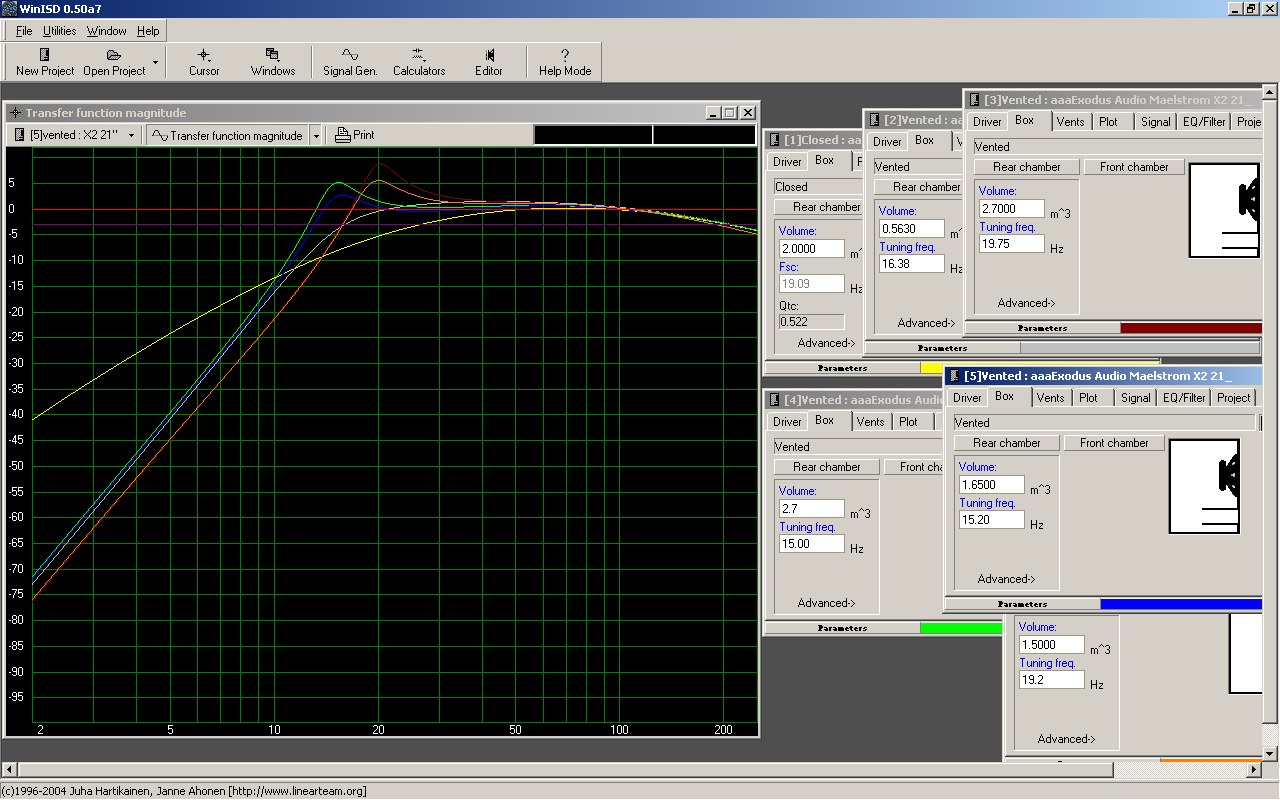
Sorry forgot to post transfer function and I can't edit the last post because it appears to be trial by fire for the n00bs like me, not that it's a bad idea either.

It would appear to likely need an eq to lower the 30-40hz range a little as is to remain flat perceptively if that's the right track.. see how the room does things first.
Attachments
As a thought, 4x http://eminence.com/pdf/lab-15.pdf (per side?) might do it. 22mm p/p Xmax on each would be enough for some real noise. Xlim is double that.
The grey curve looks good. Remember, the room is going to change the response more than anything else, and you'll get a rise on the low end from room gain. Make sure your port velocity is less than 17 m/s (the lower the better) at maximum power at any frequency, and be sure to flare both ends. Follow standard design guidelines. Some stuffing uniformly distributed throughout the box (but not allowed to get into the coil gap) will be beneficial.
EDIT: Haven't run your numbers myself but some of those curves look like they might have audible group delay.
EDIT: Haven't run your numbers myself but some of those curves look like they might have audible group delay.
I'm going to have to clarify my statement about stainless steel for these spikes. Stainless steel is usually fairly soft, so if you want to use stainless steel you need to specify an alloy like 440C, HARDENED. But if this is going on a wooden floor (God forbid), it doesn't matter.
EDIT: Haven't run your numbers myself but some of those curves look like they might have audible group delay.
What constitutes audible to you? I've heard some say sub bass group delay is not really audible but I highly doubt this (and scientific papers confirm this), it's probably one of the things sound characterisitics that put me off ported setups usually.
Anyway been working on these last two to three nights till very late am
Sealed is probably the way to go @ qtc .707 .418m3 however PR seems to have some impressive and relatively clean numbers with added cost of twice the box size and 300+ usd cost.
Still thinking about amps, I have a feeling that's going to be the hardest decision as I'm trying to avoid going cheap pro amp..
Transfer function phase is pretty much identical 150-20hz
And lastly I must thank everyone on this thread and forum for the little tidbits of info which have helped me greatly in my quest for ultimate bass
Attachments
Group delay audibility is relative to frequency, with greater delay more tolerable as frequency goes down. I don't think there are any hard numbers to go by, but if there are any sharp spikes in group delay in the passband it could be audible.What constitutes audible to you? I've heard some say sub bass group delay is not really audible but I highly doubt this (and scientific papers confirm this), it's probably one of the things sound characterisitics that put me off ported setups usually.
I have stumbled upon a set of curves i'd forgotten a long time ago.. the 'equal loudness curves' http://upload.wikimedia.org/wikipedia/commons/thumb/4/47/Lindos1.svg/2000px-Lindos1.svg.png which reckon for 100 phon reference in mid to low range its pretty flat till 100hz which it gradually increases till when you need about 128-130 db @ 20hz to keep up, vastly more db required than at 300hz.... so as far as I understand and hear on mine and other rigs.... once you approach under 30-40hz it appears to drop off even though everything is rattling, to compensate you need a metric crap-tonne of spl to get a percieved flat response.
Did Reubens have astigmatism? Why did he draw long people?
To make a long story short, you set your bass levels by ear. There is no defensible engineering solution. This will come as a surprise to many.
Tube amp, eh. I just sold a Partridge output transformer on eBay for $900. Gosh it looked good.
Dunno how I missed this, but you need to ignore the equal loudness curves completely and just aim for a decently flat response. All that crap was dealt with by the artist or musician (e.g. the pianist, not the audience, determines the relative loudness between his low-pitched notes and high-pitched notes), you don't need to fool around with it on your speaker.I have stumbled upon a set of curves i'd forgotten a long time ago.. the 'equal loudness curves' http://upload.wikimedia.org/wikipedia/commons/thumb/4/47/Lindos1.svg/2000px-Lindos1.svg.png which reckon for 100 phon reference in mid to low range its pretty flat till 100hz which it gradually increases till when you need about 128-130 db @ 20hz to keep up, vastly more db required than at 300hz.... so as far as I understand and hear on mine and other rigs.... once you approach under 30-40hz it appears to drop off even though everything is rattling, to compensate you need a metric crap-tonne of spl to get a percieved flat response. So if I rigidly stick with a flat response on paper I get a percieved dropoff in sound volume even though it's 'flat', which sure as hell isn't what I'm looking for, I want it to sound flat to me, not a graph. I'm guessing this is one of the reasons why the sub has been designed with a 16hz fs.
ANyone have any comments or feedback on especially the equal loudness curve and has anyone else designed around it. I understand it is an average and may be different to me but it's a good start for now.
EDIT: I mean, if you really want your bass to overpower everything you could do that, but it just sounds WRONG. It would be like setting your tone controls to 11.
Dunno how I missed this, but you need to ignore the equal loudness curves completely and just aim for a decently flat response. All that crap was dealt with by the artist or musician (e.g. the pianist, not the audience, determines the relative loudness between his low-pitched notes and high-pitched notes), you don't need to fool around with it on your speaker.
EDIT: I mean, if you really want your bass to overpower everything you could do that, but it just sounds WRONG. It would be like setting your tone controls to 11.
Oh my Gawd.... do you allow the artist into your living room and let him or her twiddle with your volume knob?
Speak more directly, please.Oh my Gawd.... do you allow the artist into your living room and let him or her twiddle with your volume knob?
Dunno how I missed this, but you need to ignore the equal loudness curves completely and just aim for a decently flat response. All that crap was dealt with by the artist or musician (e.g. the pianist, not the audience, determines the relative loudness between his low-pitched notes and high-pitched notes), you don't need to fool around with it on your speaker.
EDIT: I mean, if you really want your bass to overpower everything you could do that, but it just sounds WRONG. It would be like setting your tone controls to 11.
Um, not really. Most mastering is done louder than a typical home listening session. Unless you match listening level to recording level, you must boost the treble and bass to get perceptively equal tonal balance.
- Status
- This old topic is closed. If you want to reopen this topic, contact a moderator using the "Report Post" button.
- Home
- Loudspeakers
- Subwoofers
- Considering PD2450 in a huge sealed box... Seeking bass nirvana :)
